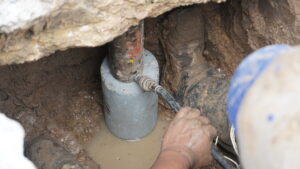Why Is Your Concrete Sinking? Understanding Uneven Surfaces
If you’ve noticed uneven sidewalks, sunken driveways, or concrete slabs with a tilt, you’re not alone. Many homeowners experience this issue and wonder, “Why is this happening?”
Concrete sinking doesn’t just make surfaces look unsightly, it can also create tripping hazards and compromise the structural integrity of your property. The good news? Understanding what causes sinking concrete can help you act quickly and prevent bigger problems down the road.
This guide will walk you through the most common reasons concrete sinks and why leveling is a practical, cost-effective solution.
The Problem Beneath the Surface
When cracks or dips in concrete appear, it’s easy to assume the surface itself is the problem. But in most cases, the issue lies below beneath that sturdy facade of pavement. Concrete relies on soil as its foundation. If that soil shifts, erodes, or loses strength, the concrete has no choice but to follow suit. Think of it like pulling the rug out from under a chair it quickly becomes unstable.
Poor Soil Compaction
Before concrete is poured, the ground beneath it must be compacted. This ensures the soil can support the weight of the slab. However, if the soil wasn’t compacted properly during the initial construction, it may compress over time. When this happens, the concrete above begins to sink or settle unevenly.
How can you spot this issue? Take a look at your driveway or patio. If you see dips forming in some areas while others remain level, chances are poor compaction is at play.
Erosion Washes Soil Away
Water is a major culprit in sinking concrete. Heavy rains, poor drainage, or leaking gutters can cause water to seep beneath concrete slabs. Over time, this water erodes the supporting soil, essentially pulling out the foundation from beneath.
This erosion issue often appears near sidewalks, patios, or driveways that slope toward your home. Water pooling in these areas is a red flag, signaling that action should be taken soon.
Clay-Rich or Expansive Soil
Certain soil types are more likely to cause problems for concrete. Clay-heavy soils, for example, expand when they absorb water and shrink when they dry out. This cycle of swelling and shrinking can lead to significant soil movement, which eventually causes the concrete above to shift or sink.
If you’ve noticed patterns of cracking or movement after rainy seasons followed by dry spells, your soil type may be to blame. Homes in regions with clay-rich soil tend to experience these issues more frequently.
Heavy Loads or Wear
Concrete surfaces are built to withstand weight, but they’re not invincible. Overloading a driveway with heavy vehicles, equipment, or even planters can compress the soil underneath over time. This compression weakens the support and forces the concrete to sink.
If your driveway doubles as a heavy-duty parking space or storage area, consider redistributing loads to avoid concentrated pressure.
Tree Roots and Natural Shifts
Nature has a way of impacting even the most solid structures. Tree roots growing near concrete can shift slabs or create voids underneath. Meanwhile, natural shifts in the ground caused by frost heaving or earthquakes can destabilize the soil. While these issues are harder to predict, they’re worth keeping an eye on if you have large trees close to any concrete surfaces.
Why Leveling is The Best Fix
Concrete leveling is a straightforward solution to the problems listed above. Unlike replacing the entire slab, leveling addresses the root cause while restoring the surface to its original position.
How Does Leveling Work?
Concrete leveling involves injecting material under the sunken slab to lift it back up. This process, often called “slab jacking” or “polyjacking,” ensures the concrete is even and stable again.
- Targeted Repairs: Concrete leveling targets specific problem areas without disturbing the surrounding environment. This makes it far less intrusive than replacement.
- Cost-Effective: Replacing a slab can be expensive and time-consuming. Leveling, on the other hand, is efficient and costs significantly less.
- Durable Results: Modern leveling techniques use materials that are long-lasting and resistant to future erosion or shifting.
When Should You Level Concrete?
If you’ve started to notice unevenness, dips, or water pooling near your concrete, it’s time to act. Addressing the issue early on can prevent further damage and reduce repair costs in the long run.
What Can You Do to Prevent Future Issues?
Sinking concrete isn’t always avoidable, but there are steps you can take to reduce the chances of it happening again.
Maintain Proper Drainage
Make sure water flows away from your home and concrete surfaces. Regularly clean gutters and downspouts to ensure they’re not contributing to water pooling.
Address Plumbing Leaks
Undetected leaks can saturate the soil beneath your home and lead to erosion. Inspect your plumbing system regularly for any issues.
Choose the Right Soil and Compact It Well
If you’re working on new construction or replacing a surface, invest in proper soil compaction. Consider soil stabilization techniques for added durability.
Distribute Weight Evenly
Avoid placing heavy objects on the same section of concrete for extended periods. If you need to store equipment or vehicles, try to spread the load across the entire surface.
Monitor Tree Growth
Check for tree roots growing too close to your concrete surfaces. If necessary, consult an arborist to discuss options for trimming roots without harming the tree.
Restore Your Concrete Today
Sunken concrete can feel like a significant issue, but it’s fixable. By addressing the underlying causes and opting for professional leveling services, you can restore both the appearance and safety of your property quickly.
If you’re unsure about the next steps, don’t hesitate to consult a concrete expert. They can assess the situation and guide you toward the best solution.

